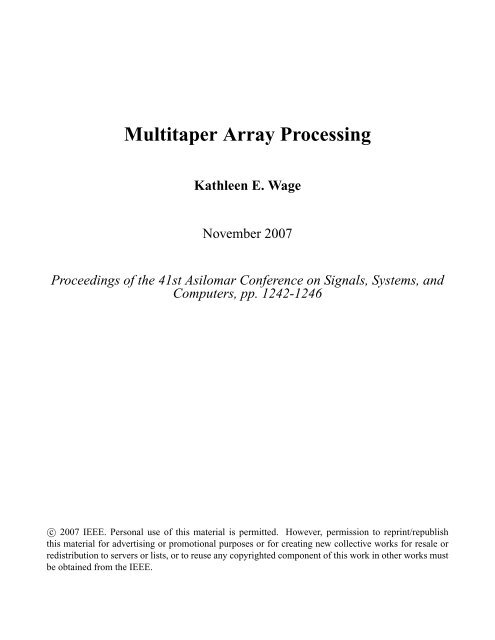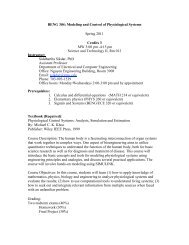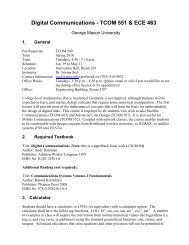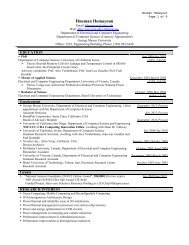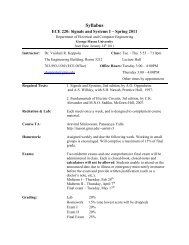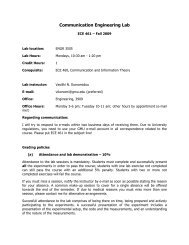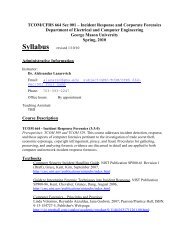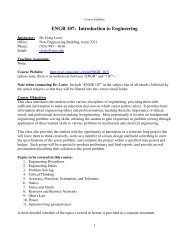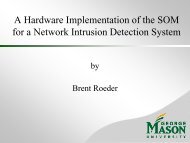Multitaper Array Processing - Department of Electrical and Computer ...
Multitaper Array Processing - Department of Electrical and Computer ...
Multitaper Array Processing - Department of Electrical and Computer ...
Create successful ePaper yourself
Turn your PDF publications into a flip-book with our unique Google optimized e-Paper software.
<strong>Multitaper</strong> <strong>Array</strong> <strong>Processing</strong><br />
Kathleen E. Wage<br />
November 2007<br />
Proceedings <strong>of</strong> the 41st Asilomar Conference on Signals, Systems, <strong>and</strong><br />
<strong>Computer</strong>s, pp. 1242-1246<br />
c○ 2007 IEEE. Personal use <strong>of</strong> this material is permitted. However, permission to reprint/republish<br />
this material for advertising or promotional purposes or for creating new collective works for resale or<br />
redistribution to servers or lists, or to reuse any copyrighted component <strong>of</strong> this work in other works must<br />
be obtained from the IEEE.
<strong>Multitaper</strong> <strong>Array</strong> <strong>Processing</strong><br />
Abstract—Thomson’s multitaper approach generates estimates<br />
<strong>of</strong> the power spectrum by averaging individual ”eigenspectra”<br />
obtained using a set <strong>of</strong> orthogonal window functions. The<br />
multitaper method is designed to work with very low sample<br />
support, typically a single snapshot <strong>of</strong> data, making it very<br />
attractive for the analysis <strong>of</strong> nonstationary or transient signals.<br />
This paper explores the use <strong>of</strong> the multitaper approach for<br />
spatial spectrum estimation in passive sonar. Several examples<br />
are given, <strong>and</strong> the problem <strong>of</strong> processing non-planewave signals<br />
is briefly discussed using an example motivated by a deep water<br />
propagation experiment.<br />
I. INTRODUCTION<br />
Adaptive array processing algorithms facilitate the detection<br />
<strong>and</strong> localization <strong>of</strong> quiet sources by nulling out noise <strong>and</strong><br />
interference. Most adaptive processors rely on time averages<br />
to generate the statistics (usually a sample covariance matrix)<br />
required for weight vector calculations. When the inputs are<br />
non-stationary, the processor has fewer time snapshots to work<br />
with, <strong>and</strong> the result is <strong>of</strong>ten substantial degradation in performance.<br />
Low sample support is a significant problem for the<br />
large aperture arrays currently used in passive sonar [1]. The<br />
signals recorded on arrays in the ocean can be non-stationary<br />
for a variety <strong>of</strong> reasons, including source <strong>and</strong>/or receiver<br />
motion, environmental fluctuations, <strong>and</strong> transient excitation <strong>of</strong><br />
sources.<br />
The multitaper method, formulated by Thomson for nonparametric<br />
spectral estimation [2], is designed to work with<br />
low sample support. <strong>Multitaper</strong> estimates are <strong>of</strong>ten formed<br />
using a single snapshot <strong>of</strong> data. Thomson’s basic idea is to<br />
apply a set <strong>of</strong> orthonormal tapers (windows) to the data <strong>and</strong><br />
then average the spectra obtained with these windows. Averaging<br />
over different tapers reduces the variance <strong>of</strong> the spectral<br />
estimate, in the same way that averaging over snapshots in the<br />
conventional Welch-Bartlett approach [3] reduces the variance.<br />
While the multitaper method has been used extensively in<br />
geophysical time series analysis, very few researchers have applied<br />
it to the spatial spectral estimation problem. Drosopoulos<br />
<strong>and</strong> Haykin used a multitaper approach to solve a low-angle<br />
tracking radar problem [4]. In a series <strong>of</strong> papers Clark, Scharf,<br />
<strong>and</strong> Mullis investigated quadratic estimators <strong>of</strong> the frequencywavenumber<br />
spectrum, including a multidimensional version<br />
Work supported by an Office <strong>of</strong> Naval Research Young Investigator Award<br />
(N00014-05-1-0639).<br />
Kathleen E. Wage<br />
<strong>Department</strong> <strong>of</strong> <strong>Electrical</strong> <strong>and</strong> <strong>Computer</strong> Engineering<br />
George Mason University<br />
4400 University Drive, MSN 1G5<br />
Fairfax, VA 22030-4444, USA<br />
kwage@gmu.edu<br />
<strong>of</strong> the Thomson estimator [5], [6], [7]. Liu <strong>and</strong> Van Veen<br />
combined the multitaper method with the minimum variance<br />
method [8]. Their approach requires estimation <strong>of</strong> a covariance<br />
matrix, thus it requires more snapshots than the st<strong>and</strong>ard<br />
multitaper implementation. Onn <strong>and</strong> Steinhardt considered the<br />
problem <strong>of</strong> detecting a sinusoid at a known frequency <strong>and</strong><br />
unknown direction <strong>of</strong> arrival using a small set <strong>of</strong> sensors [9].<br />
This paper investigates the application <strong>of</strong> multitaper method<br />
to the passive sonar problem. The following section presents<br />
a framework for multitaper array processing <strong>and</strong> discusses the<br />
detection <strong>of</strong> planewave components. Section III describes the<br />
performance <strong>of</strong> the multitaper processor using several examples,<br />
including one that illustrates the problem <strong>of</strong> processing<br />
non-planewave signals. Section IV concludes the paper.<br />
II. MULTITAPER ARRAY PROCESSING FRAMEWORK<br />
In addition to Thomson’s seminal paper from 1982, a<br />
number <strong>of</strong> other sources describe the multitaper method. The<br />
textbook by Percival <strong>and</strong> Walden is an excellent introduction<br />
to multitaper spectral estimation [10]. The book chapter by<br />
Drosopolous <strong>and</strong> Haykin provides a tutorial on using multitaper<br />
methods for radar applications [4]. For a condensed<br />
overview <strong>of</strong> the multitaper method, see the recent article by<br />
Thomson [11].<br />
A. Beamspace interpretation <strong>of</strong> a multitaper processor<br />
From an array processing perspective, the multitaper approach<br />
consists <strong>of</strong> a beamspace processor followed by a<br />
weighted averaging operation. Figure 1 shows a basic framework<br />
for multitaper processing <strong>of</strong> narrowb<strong>and</strong> sonar receptions.<br />
First, the data is passed through a processor that projects<br />
the data into several orthogonal beams centered around the<br />
angle <strong>of</strong> interest θ. The beamspace is defined by the set <strong>of</strong><br />
orthogonal weight vectors contained in the matrix W. The<br />
kth weight vector is the array response vector v(θ) multiplied<br />
by a window (taper) uk, i.e.,<br />
wk(θ) = uk ⊙ v(θ), (1)<br />
where ⊙ represents the Hadamard product (element-wise<br />
multiplication) <strong>of</strong> the two vectors. The columns <strong>of</strong> W are<br />
orthogonal, assuming that the set <strong>of</strong> tapers are chosen to<br />
be orthogonal. Thomson suggests using the discrete prolate
p(Ω)<br />
presidual<br />
+<br />
+ -<br />
Beamspace<br />
Processor<br />
W H (θ)<br />
pline<br />
q(θ)<br />
Compute<br />
Continuous<br />
Spectrum<br />
Detect &<br />
Estimate<br />
Line Spectra<br />
SMT(θ)<br />
Line spectra<br />
Fig. 1. <strong>Multitaper</strong> array processing framework. The multitaper approach<br />
projects the narrowb<strong>and</strong> pressure field data into an orthogonal beamspace<br />
<strong>and</strong> computes the spectral estimate by averaging over the beam outputs. An<br />
iterative algorithm is used to remove planewave (line) components.<br />
dB<br />
dB<br />
10<br />
0<br />
−10<br />
−20<br />
−30<br />
−40<br />
10<br />
0<br />
−10<br />
−20<br />
−30<br />
−40<br />
Spatial response <strong>of</strong> tapers 1 <strong>and</strong> 2<br />
k=1<br />
k=2<br />
−0.05 0 0.05<br />
cos(theta)<br />
Spatial response <strong>of</strong> tapers 3 <strong>and</strong> 4<br />
k=3<br />
k=4<br />
−0.05 0 0.05<br />
cos (theta)<br />
Fig. 2. Beam response (spatial frequency response) <strong>of</strong> four discrete prolate<br />
spheroidal sequence tapers as a function <strong>of</strong> the cosine <strong>of</strong> the angle. The tapers<br />
are designed for a 128-element equally-spaced array.<br />
spheroidal sequences (DPSS) since they are designed to maximize<br />
the power concentrated in a narrow angular region.<br />
Figure 2 shows the beam response (spatial frequency response)<br />
<strong>of</strong> a set <strong>of</strong> four DPSS tapers as a function <strong>of</strong> the cosine <strong>of</strong><br />
the angle. The dashed lines in the plots indicate the width <strong>of</strong><br />
the angular region the tapers are designed to sample. Given a<br />
desired beamwidth, the number <strong>of</strong> tapers guaranteed to have<br />
good sidelobe characteristics is limited, thus the multitaper<br />
approach uses only these tapers.<br />
The output <strong>of</strong> the narrowb<strong>and</strong> beamspace processor designed<br />
with K tapers is the K-dimensional vector q:<br />
q(θ, Ω) = W H (θ)p(Ω). (2)<br />
To compute an estimate <strong>of</strong> the spatial spectrum, the multitaper<br />
processor averages the outputs <strong>of</strong> the beamspace processor,<br />
Power (dB)<br />
50<br />
40<br />
30<br />
20<br />
10<br />
0<br />
−10<br />
−20<br />
−30<br />
128 elements, λ/2 spacing, SNR=30 dB<br />
Non−adaptive<br />
Adaptive<br />
−40<br />
−1 −0.5 0 0.5 1<br />
cos(theta)<br />
Fig. 3. <strong>Multitaper</strong> spatial spectrum for a planewave at broadside (u=0) with<br />
SNR <strong>of</strong> 30 dB estimated using a 128-element array with half-wavelength spacing.<br />
The plot compares the non-adaptive <strong>and</strong> adaptive multitaper estimators.<br />
i.e., the estimate is<br />
SMT(θ) =<br />
K<br />
αk|qk(θ)| 2 , (3)<br />
k=1<br />
where αk is the weight given to the kth beam output. The<br />
weights can be set to 1<br />
K for a simple average or determined<br />
adaptively. See Thomson’s paper [2] for an explanation <strong>of</strong><br />
the adaptive weight calculation. Figure 3 compares the output<br />
<strong>of</strong> the non-adaptive <strong>and</strong> adaptive multitaper estimators for an<br />
environment containing a single planewave source at broadside<br />
in a background <strong>of</strong> white sensor noise. The array has 128<br />
elements with half-wavelength spacing, <strong>and</strong> the estimate was<br />
generated using the four DPSS tapers shown above. Note that<br />
choosing the beamwidth <strong>of</strong> the multitaper processor requires a<br />
trade<strong>of</strong>f <strong>of</strong> resolution <strong>and</strong> variance, i.e., using a large number<br />
<strong>of</strong> tapers yields a significant reduction in variance with a<br />
corresponding reduction in resolution. Figure 3 illustrates how<br />
the adaptive weighting can significantly reduce the sidelobes<br />
associated with a loud source by applying a data-dependent<br />
weighting to the tapered spectral estimates.<br />
B. Detection <strong>of</strong> planewave components<br />
Equation 3 provides an estimate <strong>of</strong> the continuous spatial<br />
spectrum, but as Thomson suggests, line components need<br />
to be estimated separately. In the passive sonar problem,<br />
line components correspond to planewave arrivals. These can<br />
be estimated using a linear regression on the output <strong>of</strong> the<br />
beamspace processor. Drosopoulos <strong>and</strong> Haykin discuss the<br />
detection <strong>of</strong> line components in detail for a radar problem [4].<br />
To work with sonar data, where the signal is typically modeled<br />
as complex Gaussian, these techniques must be extended.<br />
The CFAR subspace detection scheme developed by Jin <strong>and</strong><br />
Friedl<strong>and</strong>er provides a useful framework for analyzing <strong>and</strong><br />
implementing planewave detectors [12].<br />
Consider a received signal consisting <strong>of</strong> a single planewave<br />
plus noise:<br />
p = ˜ bv(θ) + n. (4)
P D<br />
1<br />
0.8<br />
0.6<br />
Broadside source; PFA=0.001<br />
0.4<br />
K=2<br />
K=3<br />
0.2<br />
K=4<br />
K=8<br />
K=16<br />
0<br />
−20 −10 0 10 20<br />
Input (per phone) SNR (dB)<br />
30 40<br />
Fig. 4. Detection performance as a function <strong>of</strong> SNR <strong>and</strong> the number <strong>of</strong> tapers.<br />
Results shown are for a 128-element array with half-wavelength spacing. The<br />
detector uses a single snapshot <strong>and</strong> the false alarm probability is fixed at<br />
0.001.<br />
The output <strong>of</strong> the kth filter steered towards θ is:<br />
qk(θ) = w H k (θ)p = ˜ bµk + w H k<br />
where µk is the DC component <strong>of</strong> the kth taper:<br />
µk =<br />
(θ)n, (5)<br />
N<br />
uk(n). (6)<br />
n=1<br />
In this case the output <strong>of</strong> the beamspace processor is<br />
q(θ) = W H beam (θ)p = ˜ bµ + noise.<br />
Linear regression yields a simple estimate <strong>of</strong> the complex<br />
amplitude ˜ b:<br />
ˆ b(θ) = (µ H µ) −1 µ H q(θ). (7)<br />
Based on Jin <strong>and</strong> Friedl<strong>and</strong>er’s results, a CFAR statistic for<br />
detecting the presence <strong>of</strong> a single planewave in noise is<br />
qHPµq qH ∼ F statistic, (8)<br />
Porthq<br />
where Pµ is the projection matrix for the subspace spanned<br />
by the vector µ <strong>and</strong> Porth represents the projection into the<br />
orthogonal subspace: Porth = I − Pµ. If additional data are<br />
available, the test statistic can be averaged over L snapshots:<br />
<br />
l qH l Pµql<br />
<br />
l qH l Porthql<br />
. (9)<br />
Figure 4 shows the probability <strong>of</strong> detection PD versus SNR<br />
for a false alarm rate <strong>of</strong> 0.001 <strong>and</strong> varying numbers <strong>of</strong> tapers.<br />
Note that for this single planewave case, increasing the number<br />
<strong>of</strong> tapers improves PD up to a point. Beyond eight tapers,<br />
performance doesn’t improve much since the higher tapers do<br />
not sample the center <strong>of</strong> the b<strong>and</strong> (the angle associated with<br />
the planewave) very well.<br />
An iterative scheme is useful for detecting low-level<br />
planewave components in the presence <strong>of</strong> loud interferers. As<br />
Power (dB)<br />
Power (dB)<br />
Power (dB)<br />
40<br />
20<br />
0<br />
No planewave detection<br />
−0.2 −0.1 0 0.1 0.2<br />
40<br />
20<br />
0<br />
One detection iteration<br />
−0.2 −0.1 0 0.1 0.2<br />
40<br />
20<br />
0<br />
Two detection iterations<br />
−0.2 −0.1 0 0.1 0.2<br />
cos(θ)<br />
Fig. 5. Example <strong>of</strong> iterative detection <strong>of</strong> planewave components. The plots<br />
show results for a 128-element array with half-wavelength spacing. Two<br />
planewaves with SNR’s <strong>of</strong> 20 dB <strong>and</strong> -10 dB relative to the white noise floor<br />
are incident on the array. With no planewave detection, the output spectrum<br />
is the blurred peak shown in the top plot. The results <strong>of</strong> the first detection<br />
iteration (shown in the middle plot) indicate that the strong planewave is<br />
detected. After the second detection iteration (bottom plot), both planewaves<br />
are visible.<br />
shown in Figure 1, the planewave signals are estimated <strong>and</strong><br />
removed after one pass through the beamspace processor. The<br />
residual signal is fed back through the beamspace processor<br />
again, <strong>and</strong> the planewave detection/estimation algorithm is<br />
repeated. Figure 5 illustrates the output <strong>of</strong> the multitaper<br />
processor after each iteration when the input signal consists<br />
<strong>of</strong> two closely-spaced planewaves. For this simulation the<br />
array has 128 elements with half-wavelength spacing. The<br />
two sources have different power levels: the first has 20 dB<br />
signal-to-noise ratio (SNR) with respect to the white noise<br />
floor <strong>and</strong> the second has -10 dB SNR with respect to the<br />
noise floor. As Figure 5 shows, when no planewave detection<br />
is implemented, the sources appear as a blurred peak in the<br />
output spectrum. After the first iteration, the strong source<br />
is detected, but the weak source still appears to be blurred.<br />
After the second iteration, both the strong <strong>and</strong> weak sources<br />
are clearly visible in the output.<br />
III. EXAMPLES<br />
This section compares the performance <strong>of</strong> the multitaper<br />
processor to a st<strong>and</strong>ard adaptive beamformer, <strong>and</strong> briefly discusses<br />
the modifications necessary to process non-planewave<br />
signals.
A. <strong>Multitaper</strong> versus Minimum Power Distortionless Response<br />
Figure 6 compares the performance <strong>of</strong> the multitaper processor<br />
with the performance <strong>of</strong> the st<strong>and</strong>ard minimum power<br />
distortionless response (MPDR) processor for a complicated<br />
simulation example. The MPDR weight vector is defined as<br />
wMPDR(θ) =<br />
R −1v(θ) v(θ) H R−1 . (10)<br />
v(θ)<br />
R is the sample covariance matrix <strong>of</strong> the received pressure<br />
R =<br />
L<br />
l=1<br />
plp H l<br />
+ γI, (11)<br />
where pl is the lth data snapshot <strong>and</strong> γ is an optional diagonal<br />
loading parameter (needed to stabilize the inverse). See the<br />
text by Van Trees for a thorough description <strong>of</strong> the MPDR<br />
approach [13].<br />
In this example, the array consists <strong>of</strong> 128 elements with halfwavelength<br />
spacing. The environment contains one moving<br />
source <strong>and</strong> 13 stationary interferers. The moving source has a -<br />
10 dB SNR with respect to the white noise floor; the stationary<br />
interferers have varying power levels. Note that the interferers<br />
located near endfire (four near forward endfire <strong>and</strong> four near<br />
aft endfire) are perfectly coherent. Each processor uses 4<br />
snapshots to compute its estimates. The MPDR processor<br />
requires diagonal loading to stabilize the inversion <strong>of</strong> its<br />
sample covariance matrix 1 . Figure 6 shows that the multitaper<br />
processor produces spatial spectra with significantly lower<br />
variance than the MPDR processor. As a result the low-level<br />
moving source is easier to see in the multitaper output than it<br />
is in the MPDR output. In addition, the multitaper processor<br />
h<strong>and</strong>les the coherent sources without a problem, whereas the<br />
MPDR processor nulls out some <strong>of</strong> the coherent signal components.<br />
While forward-backward averaging can help the MPDR<br />
processor with coherent sources, this would require additional<br />
computation that the multitaper approach does not require. As<br />
Figure 6 illustrates, the multitaper processor performs very<br />
well for a long array using only a few snapshots.<br />
B. Application <strong>of</strong> multitapering to non-planewave sources<br />
In some underwater environments the arriving signal is<br />
better described as a sum <strong>of</strong> the propagating modes <strong>of</strong> the<br />
waveguide than as a sum <strong>of</strong> planewaves. Consider a simulation<br />
example motivated by the SPICE04 experiment [14] 2 . The top<br />
plot in Figure 7 shows the reception at 1000 km range due<br />
to a transient source with a center frequency <strong>of</strong> 250 Hz. As<br />
is typical in deep water, the early-arriving energy corresponds<br />
to the higher modes <strong>and</strong> the late-arriving energy corresponds<br />
to the lower modes. The lower plot in Figure 7 shows<br />
the planewave detection statistic for the multitaper processor<br />
designed for the 250 Hz bin. Based on this plot, the early part<br />
1 A reasonable loading level was used; no attempt was made to optimize<br />
the choice <strong>of</strong> loading level.<br />
2 The array configuration for the simulation does not match the SPICE04<br />
experiment exactly. Specifically, the sensor spacing for the simulation has<br />
been adjusted to half-wavelength to eliminate grating lobes.<br />
<strong>of</strong> the arrival pattern consists <strong>of</strong> the sum <strong>of</strong> two planewaves<br />
whose angle changes as a function <strong>of</strong> time. This is consistent<br />
with the WKB approximation, which says a mode can be<br />
thought <strong>of</strong> as the sum <strong>of</strong> an up- <strong>and</strong> a down-going planewave<br />
(see Figure 8 showing the shape <strong>of</strong> mode 40 as a function <strong>of</strong><br />
depth). While WKB theory works well for the higher order<br />
modes, it typically breaks down for the lower modes, which<br />
is why the multitaper display for the later part <strong>of</strong> the arrival<br />
pattern is more difficult to interpret. Since the low modes<br />
cannot be written as the sum <strong>of</strong> up/down-going planewaves,<br />
the multitaper detector must be modified to accurately detect<br />
these signals.<br />
IV. SUMMARY<br />
This paper applied Thomson’s multitaper method to the<br />
passive sonar problem. As the example in Section III-A<br />
demonstrated, the multitaper processor can reliably detect lowlevel<br />
planewave arrivals in a complicated background containing<br />
coherent <strong>and</strong> incoherent interference sources. Additional<br />
work is ongoing to adapt the multitaper method to process nonplanewave<br />
signals, such as those recorded during SPICE04.<br />
REFERENCES<br />
[1] A. B. Baggeroer <strong>and</strong> H. Cox, “Passive Sonar Limits Upon Nulling<br />
Multiple Moving Ships with Large Aperture <strong>Array</strong>s,” in Proceedings<br />
<strong>of</strong> the 33rd Asilomar Conference on Signals, Systems, <strong>and</strong> <strong>Computer</strong>s,<br />
pp. 103–108, 1999.<br />
[2] D. J. Thomson, “Spectrum estimation <strong>and</strong> harmonic analysis,” Proceedings<br />
<strong>of</strong> the IEEE, vol. 70, pp. 1055–1096, September 1982.<br />
[3] P. Welch, “The use <strong>of</strong> the Fast Fourier Transform for the estimation <strong>of</strong><br />
power spectra,” IEEE Trans. on Audio <strong>and</strong> Electroacoustics, vol. AU-15,<br />
pp. 70–73, June 1967.<br />
[4] A. Drosopoulos <strong>and</strong> S. Haykin, “Adaptive radar parameter estimation<br />
with Thomson’s multiple window method,” in Adaptive Radar Detection<br />
<strong>and</strong> Estimation, New York, NY: John Wiley, 1991.<br />
[5] M. P. Clark, L. L. Scharf, <strong>and</strong> C. T. Mullis, “Quadratic estimators <strong>of</strong><br />
the frequency-wavenumber spectrum,” in Proceedings <strong>of</strong> the International<br />
Conference on Acoustics, Speech, <strong>and</strong> Signal <strong>Processing</strong>, vol. 4,<br />
pp. 2329–2332, April 1991.<br />
[6] M. P. Clark <strong>and</strong> L. L. Scharf, “Frequency-wavenumber spectrum analysis<br />
using quadratic estimators,” in Proceedings <strong>of</strong> the 6th SP Workshop on<br />
Statistical Signal <strong>and</strong> <strong>Array</strong> <strong>Processing</strong>, pp. 416–419, October 1992.<br />
[7] M. P. Clark <strong>and</strong> L. L. Scharf, “Efficient frequency-wavenumber spectrum<br />
estimation using sliding time-division windows,” in Proceedings <strong>of</strong><br />
the 26th Asilomar Conference on Signals, Systems, <strong>and</strong> <strong>Computer</strong>s,<br />
pp. 1116–1121, October 1992.<br />
[8] T.-C. Liu <strong>and</strong> B. D. V. Veen, “Multiple Window Based Minimum<br />
Variance Spectrum Estimation for Multidimensional R<strong>and</strong>om Fields,”<br />
IEEE Trans. on Signal <strong>Processing</strong>, vol. 40, pp. 578–589, March 1992.<br />
[9] R. Onn <strong>and</strong> A. O. Steinhardt, “A multiwindow method for spectrum<br />
estimation <strong>and</strong> sinusoid detection in an array environment,” IEEE<br />
Trans. on Signal <strong>Processing</strong>, vol. 42, pp. 3006–3015, November 1994.<br />
[10] D. B. Percival <strong>and</strong> A. T. Walden, Spectral Analysis for Physical Applications:<br />
<strong>Multitaper</strong> <strong>and</strong> Conventional Univariate Techniques. Cambridge<br />
University Press, 1993.<br />
[11] D. J. Thomson, “Jacknifing multitaper spectrum estimates,” IEEE Signal<br />
<strong>Processing</strong> Magazine, vol. 24, pp. 20–30, July 2007.<br />
[12] Y. Jin <strong>and</strong> B. Friedl<strong>and</strong>er, “A CFAR adaptive subspace detector for<br />
second-order gaussian signals,” IEEE Trans. on Signal <strong>Processing</strong>,<br />
vol. 53, pp. 871–884, March 2005.<br />
[13] H. L. Van Trees, Optimum <strong>Array</strong> <strong>Processing</strong>. New York, NY: John<br />
Wiley <strong>and</strong> Sons, 2002.<br />
[14] P. F. Worcester, M. A. Dzieciuch, L. J. V. Uffelen, D. L. Rudnick,<br />
B. D. Cornuelle, <strong>and</strong> W. H. Munk, “The SPICEX (Spice Experiment)<br />
component <strong>of</strong> the 2004 North Pacific Acoustic Laboratory (NPAL)<br />
experiment: An overview,” in J. <strong>of</strong> the Acoustical Society <strong>of</strong> America,<br />
vol. 120, p. 3020, November 2006.
Time<br />
10<br />
20<br />
30<br />
40<br />
50<br />
60<br />
70<br />
80<br />
90<br />
100<br />
<strong>Multitaper</strong> processing<br />
−1 −0.5 0 0.5 1<br />
cos(θ)<br />
(a) <strong>Multitaper</strong> processor output.<br />
50<br />
45<br />
40<br />
35<br />
30<br />
25<br />
20<br />
15<br />
10<br />
5<br />
0<br />
dB −5<br />
Time<br />
10<br />
20<br />
30<br />
40<br />
50<br />
60<br />
70<br />
80<br />
90<br />
100<br />
MPDR processing<br />
−1 −0.5 0 0.5 1<br />
cos(θ)<br />
(b) MPDR processor output.<br />
Fig. 6. Comparison <strong>of</strong> the outputs <strong>of</strong> narrowb<strong>and</strong> multitaper <strong>and</strong> minimum power distortionless response processors for a complicated scenario containing<br />
one moving source <strong>and</strong> 13 stationary interferers. The array consists <strong>of</strong> 128 elements with half-wavelength spacing. The color images show the estimated<br />
spatial spectra for 100 different trials, <strong>and</strong> the line plots at the bottom <strong>of</strong> each figure show the results for the 100th trial.<br />
Depth (m)<br />
Angle (degrees)<br />
500<br />
600<br />
700<br />
800<br />
674.5 675 675.5 676<br />
75<br />
80<br />
85<br />
90<br />
95<br />
100<br />
105<br />
Detected arrivals in MT estimate<br />
675 675.5 676<br />
Time (seconds)<br />
Fig. 7. Simulation motivated by the SPICE04 experiment. The top plot<br />
shows the received pressure field at a range <strong>of</strong> 1000 km for a transient source<br />
centered at 250 Hz.<br />
Depth (m)<br />
0<br />
500<br />
1000<br />
1500<br />
2000<br />
2500<br />
Modeshapes<br />
Md1<br />
Md5<br />
Md40<br />
−0.1 0 0.1<br />
50<br />
45<br />
40<br />
35<br />
30<br />
25<br />
20<br />
15<br />
10<br />
5<br />
0<br />
dB −5<br />
Fig. 8. Modeshapes for modes 1, 5, <strong>and</strong> 40 at 250 Hz for the SPICE04<br />
simulation environment.


